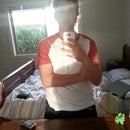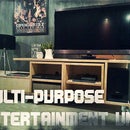Introduction: Desk Lamp
This is an desk lamp that is great project to build your skills. This is a great skill development activity. This is a lamp that can be changed to almost any other design, it incorporates aluminium and wood for a brilliant look. I created this light at school and used machines such as a milling machine and a drill press to manufacture this lamp but if they aren't available to you there are substitutes for them.
Equipment:
-File
-Soldering iron
-Drill press (optional)
-Sand paper
-Milling machine (optional)
-3D modelling software (optional)
-Hack saw
-Rule
-Panel saw
-Jaw guards
-Clamp
-Vice
-Marking out tool such as marker scribe
-Cotton wool
-Sanding block (not necessary)
Material:
-Block of wood 70 mm x 42 mm x 95 mm $3.80 but i had some lying around at school
-6oo mm strip of aluminium $2.80
-LED strip $12, for a waterproof 5metere strip, it works with a 12V power supply (from ebay)
-Polypropylene $9.50 with plenty left over
-Plastic end cap for aluminium. $0.42
-Solder
-Screws
-Bending bar you don't need to by the bending bar from design ability because you can just find a circular piece of tube.
You can get the wood, aluminium strip and polypropylene from http://www.designability.com.au/project/ecolamp
This website design ability has some really good DIY projects.
Step 1: Body
The first step for me was to create a design so i drew one in a 3D modelling software called Creo. but you can draw a design on a piece of paper. Also create a template for how you are going to bend the aluminium strip.
I marked the aluminium out to the correct size using a rule and a marker.
Than using a hacksaw, i cut the aluminium strip to the correct size.
I than used a piece of hollow metal tube that i have tightened in the vice and used jaw guards to prevent marking the tube. I than extremely carefully bent the aluminum by pushing it on the pole and moving the aluminum to bend it.
After that i filed the top of the aluminium to smooth it out.
Step 2:
Using scissors i cut my Led strip to my desired length (it is very important to cut the Led strip on where it is indicated).
Following on i used a soldering iron to de-solder (heated up existing solder that was already on there and removing them) the wires that were came soldered onto the Led strip. I de-soldered the existing wires because i need to solder the wires from the 12v power plug on them spots.
When i was ready to stick my Led strip on the aluminium i pilled off the back of the protective layer of the double sided tape which is on the back of the Led strip and stuck it on.
I than cut a piece of polypropylene that was going to fit in the aluminium. This acts like a defuser.
Step 3:
Using the milling machine i cut out the base but you can just cut it out on a band saw or a hand held saw.
After that i positioned my aluminum strip so the center of my base is leaving equal space on each side. when i positioned it i asked a friend to hold the aluminium in position while i used a screw driver to put the screws in.
I used a drill press to drill a hole through my base and my aluminium. I used a portable vice to hold the base in place and a drill bit that would make a sub substantial hole for the wire to go through. This hole went completely through the base.
I than sanded my base starting with 120 course sandpaper and finishing with 400 course but you can do it how you prefer it but this gave me a very soft finish.
After that i used cotton wool to apply the Scandinavian oil to finish to finish the base, i used four coats. I didn't do this until the end but i advise you do it now.
Step 4:
one of the last steps was to solder the wires from the 12V power plug on the soldering spots that are on the Led. Two things to make sure is that the wire passes through the hole in the base before you solder and to test what wires connect to which soldering spots to make sure your Led strip works.
Than just slide the polypropylene in.
Step 5: Conclusion
I personally think that my Desk Lamp looks good and i am proud of the design. You can make many more designs and possibilities. i didn't have the end cap so i couldn't put it on and the reason i left the wires exposed was because our teacher said that we had to relate the light to a designer that left the wires exposed in his lights, if you don't like this look you can simply cover it up with polypropylene or you can use heat shrink. Again this is a great skill building activity to enhance your skills in the workshop. I hope you enjoyed.












